
Alopecurus myosuroides is an annual grass, found on cultivated and waste land. It is also known as slender meadow foxtail, black-grass, twitch grass, and black twitch.

Lagurus is a genus of Old World plants in the grass family, native to the Mediterranean Basin and nearby regions, from Azores and the Canary Islands to Crimea and Saudi Arabia. It is also naturalized in Australia, New Zealand, Ireland and Great Britain, and scattered locations in the Americas. The only known species is Lagurus ovatus, commonly called hare's-tail, hare's-tail grass or bunnytail. It is also grown as an ornamental plant for its attractive flower panicles.

Bromus hordeaceus, the soft brome, is an annual or biennial species of grass in the true grass family (Poaceae). It is also known in North America as bull grass, soft cheat, and soft chess.

Festuca rubra is a species of grass known by the common name red fescue or creeping red fescue. It is widespread across much of the Northern Hemisphere and can tolerate many habitats and climates. It is best adapted to well-drained soils in cool, temperate climates; it prefers shadier areas and is often planted for its shade tolerance. Wild animals browse it, but it has not been important for domestic forage due to low productivity and palatability. It is also an ornamental plant for gardens.

Elymus canadensis, commonly known as Canada wild rye or Canadian wildrye, is a species of wild rye native to much of North America. It is most abundant in the central plains and Great Plains. It grows in a number of ecosystems, including woodlands, savannas, dunes, and prairies, sometimes in areas that have been disturbed.
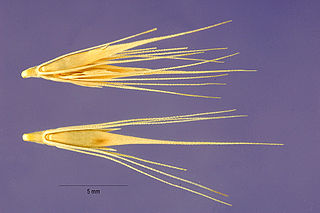
Hordeum depressum is a species of barley known by the common names low barley and dwarf barley. It is native to the western United States from Idaho to California, where it can be found in moist habitats such as vernal pools. This is a small annual grass forming petite patches of thin, hairy leaves and erect stems to half a meter in maximum height. The green or reddish green inflorescence is 2 to 6 centimeters long and about half a centimeter wide. Like other barleys the spikelets come in triplets. There is a large fertile central spikelet about a centimeter long and two smaller, often sterile spikelets on pedicels, each 3 to 5 millimeters long.

Bromus madritensis is a species of brome grass known by the common name compact brome. The specific epithet madritensis refers to Madrid, Spain. It has a diploid number of 28.
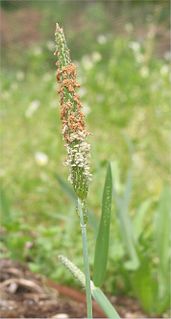
Alopecurus geniculatus is a species of grass known by the common name water foxtail or marsh foxtail. It is native to much of Eurasia and introduced into North America, South America, and Australia. It grows in moist areas.
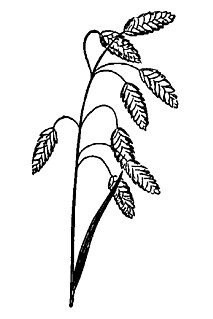
Bromus briziformis is a species of brome grass known by the common name rattlesnake brome. The specific epithet briziformis comes from the resemblance of the grass to grasses of the genus Briza, particularly Briza maxima. The common name is derived from the resemblance of the spikelets to the rattles of rattlesnakes. The grass has a diploid number of 14.

Calamagrostis koelerioides, the fire reedgrass, is a species of grass native to western North America in the United States. It ranges from western Wyoming to Washington state, south to Mexico. It is found in many habitat types.

Agrostis densiflora is a species of grass known by the common name California bent grass. It is endemic to the coast of northern and central California, United States, where it grows in habitat along the immediate coastline, such as dunes and bluffs.
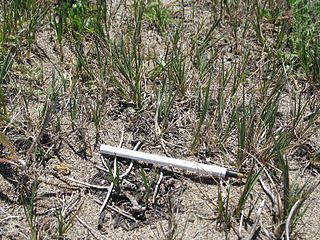
Agrostis pallens is a species of grass known by the common name seashore bentgrass.
Hordeum intercedens is an diploid, annual species of wild barley known by the common names bobtail barley and vernal barley. It is native to southern California and northern Baja California, where it is an increasingly rare member of the flora in saline and alkaline soils near seasonal waterflows and vernal pool habitats. Today most occurrences are located on the Channel Islands of California; many of the occurrences known from the mainland have been extirpated in the process of land development. This is an annual grass growing erect to bent in small tufts with stems up to 40 centimeters long. The inflorescence is a green spike up to 6.5 centimeters long made up of awned spikelets between 1 and 2 centimeters long.
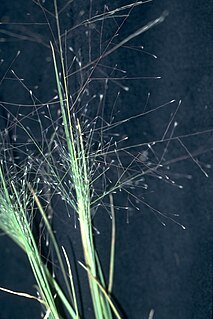
Muhlenbergia asperifolia is a species of grass known as alkali muhly and scratchgrass. It is native to much of North America, including most of southern Canada, most of the continental United States except for the southeastern region, and parts of northern Mexico. It also grows in South America.

Paspalum dilatatum is a species of grass known by the common name dallisgrass, Dallas grass, or sticky heads. It is native to Brazil and Argentina, but it is known throughout the world as an introduced species and at times a common weed. Its rapid growth and spreading rhizomes make it an invasive pest in some areas. It is present in the southern half of North America, southern Europe, much of Africa, Australia, New Zealand, and many tropical and subtropical areas.

Poa douglasii is a species of grass known by the common names Douglas' bluegrass and sand dune bluegrass. It is endemic to the coastline of California, where it grows in shifting sand dunes. It can be found mostly along the Central Coast and Channel Islands, and occasionally on the North Coast north of Mendocino. It is a perennial grass growing small, dense clumps up to about 30 centimeters in maximum height. It grows from a network of long rhizomes and stolons that anchor the grass to its loose sandy substrate; this network may be up to one meter long. The inflorescence is a dense, oval-shaped series of overlapping spikelets. The grass is dioecious, with male and female individuals producing different types of flowers in their inflorescences. This species, like many sand-dune endemic plants, is threatened by invasive species.

Sporobolus airoides is a species of grass known by the common name alkali sacaton. It is native to western North America, including the Western United States west of the Mississippi River, British Columbia and Alberta in Canada, and northern and central Mexico. It grows in many types of habitat, often in alkali soils, such as in California desert regions.

Sporobolus cryptandrus is a species of grass known as sand dropseed. It is native to North America, where it is widespread in southern Canada, most of the United States, and northern Mexico.

Sporobolus vaginiflorus is a species of grass known by the common names poverty grass, poverty dropseed, and sheathed dropseed.
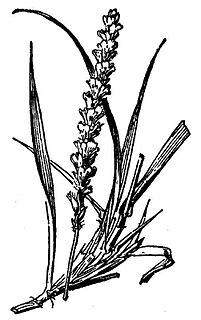
Pleuraphis mutica is a species of grass known by the common name tobosa, or tobosa grass. It is native to Northern Mexico, and the Southwestern United States, in Arizona, New Mexico, Oklahoma, and Texas.



















